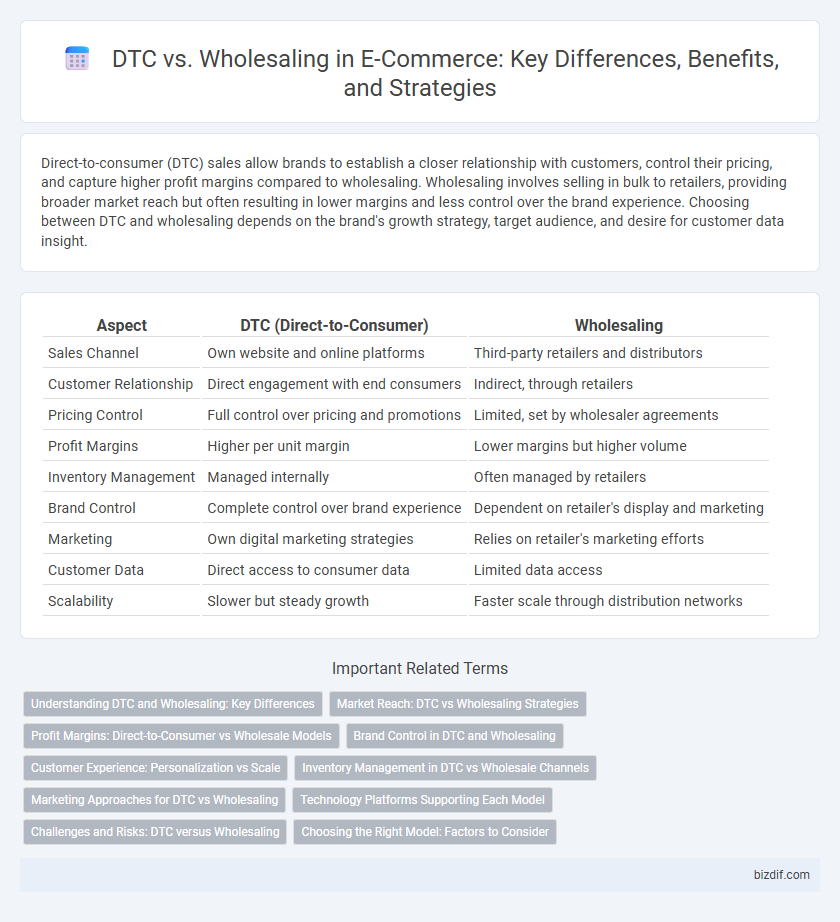Direct-to-consumer (DTC) sales allow brands to establish a closer relationship with customers, control their pricing, and capture higher profit margins compared to wholesaling. Wholesaling involves selling in bulk to retailers, providing broader market reach but often resulting in lower margins and less control over the brand experience. Choosing between DTC and wholesaling depends on the brand's growth strategy, target audience, and desire for customer data insight.
Table of Comparison
| Aspect | DTC (Direct-to-Consumer) | Wholesaling |
|---|---|---|
| Sales Channel | Own website and online platforms | Third-party retailers and distributors |
| Customer Relationship | Direct engagement with end consumers | Indirect, through retailers |
| Pricing Control | Full control over pricing and promotions | Limited, set by wholesaler agreements |
| Profit Margins | Higher per unit margin | Lower margins but higher volume |
| Inventory Management | Managed internally | Often managed by retailers |
| Brand Control | Complete control over brand experience | Dependent on retailer's display and marketing |
| Marketing | Own digital marketing strategies | Relies on retailer's marketing efforts |
| Customer Data | Direct access to consumer data | Limited data access |
| Scalability | Slower but steady growth | Faster scale through distribution networks |
Understanding DTC and Wholesaling: Key Differences
Direct-to-Consumer (DTC) sales involve brands selling products straight to customers, bypassing intermediaries, which allows for greater control over branding, pricing, and customer data. Wholesaling entails selling goods in bulk to retailers or distributors, who then sell to end consumers, often resulting in lower profit margins but higher volume sales. Key differences include DTC's focus on personalized customer experience and data insights, whereas wholesaling emphasizes broad market reach and scalability through established retail networks.
Market Reach: DTC vs Wholesaling Strategies
Direct-to-consumer (DTC) strategies enable brands to reach a targeted audience through digital channels, fostering personalized customer experiences and collecting valuable first-party data to refine marketing efforts. Wholesaling strategies expand market reach by leveraging established retail networks and bulk distribution, allowing access to broader demographics and diverse geographic locations without the need for direct consumer interaction. Combining DTC and wholesaling approaches can optimize overall market penetration by balancing personalized engagement with large-scale product availability.
Profit Margins: Direct-to-Consumer vs Wholesale Models
Direct-to-Consumer (DTC) models typically yield higher profit margins by eliminating intermediary costs and enabling brands to set retail prices directly. Wholesale models generally operate with lower profit margins due to bulk pricing and distributor markups but benefit from larger volume sales. Evaluating profit margins requires balancing the higher per-unit earnings in DTC against the scalable distribution efficiencies in wholesale channels.
Brand Control in DTC and Wholesaling
DTC (Direct-to-Consumer) offers brands full control over their messaging, pricing, and customer experience, enabling personalized marketing and stronger brand loyalty. Wholesaling limits control as third-party retailers manage product presentation, pricing, and customer engagement, which can dilute brand identity. Maintaining consistent brand values and maximizing profit margins is more achievable through a direct DTC approach.
Customer Experience: Personalization vs Scale
Direct-to-consumer (DTC) models excel in delivering personalized customer experiences through tailored product recommendations, customized marketing, and direct feedback loops. Wholesaling prioritizes scale, offering broader distribution and lower prices but often sacrifices individual customer personalization. The trade-off between DTC and wholesaling centers on balancing intimate customer interaction with expansive market reach in e-commerce.
Inventory Management in DTC vs Wholesale Channels
Inventory management in DTC channels offers greater control over stock levels and demand forecasting, reducing overstock and stockouts through real-time data integration. Wholesale channels often require bulk inventory commitments, leading to less flexibility and higher risks of excess inventory due to longer sales cycles and less frequent order updates. Efficient inventory strategies in DTC leverage direct consumer insights, while wholesale relies on retailer demand predictions and supply chain coordination.
Marketing Approaches for DTC vs Wholesaling
Direct-to-consumer (DTC) marketing leverages personalized digital campaigns, social media engagement, and targeted email marketing to build strong brand-consumer relationships and drive higher conversion rates. Wholesaling marketing focuses on B2B partnerships, trade shows, and bulk order promotions, emphasizing volume sales and long-term retailer collaborations. DTC strategies prioritize customer data analytics for precise audience targeting, while wholesaling relies on relationship management and distributor networks to expand market reach.
Technology Platforms Supporting Each Model
DTC e-commerce platforms like Shopify and BigCommerce offer seamless customization, integrated payment processing, and direct customer engagement tools that enhance brand control and personalized marketing. Wholesaling relies on B2B-focused platforms such as Alibaba and Faire, which support bulk ordering, inventory management, and multi-vendor integration, optimizing supply chain efficiency. Advanced analytics and API integrations in both models drive data-driven decisions, but DTC platforms prioritize customer experience while wholesale platforms emphasize distribution scalability.
Challenges and Risks: DTC versus Wholesaling
Direct-to-consumer (DTC) businesses face challenges such as high customer acquisition costs, inventory management complexities, and increased responsibility for marketing and customer service. Wholesaling carries risks including lower profit margins, dependency on retailer relationships, and reduced direct control over the brand experience. Both models require strategic risk management to optimize supply chain efficiency and maintain competitive positioning in the e-commerce landscape.
Choosing the Right Model: Factors to Consider
Selecting between Direct-to-Consumer (DTC) and wholesaling depends heavily on factors such as target audience engagement, profit margins, and brand control. DTC offers higher margins and direct customer insights, making it ideal for brands prioritizing personalized marketing and long-term loyalty. Wholesaling suits businesses aiming for broader distribution and faster scaling through established retail partnerships, despite lower per-unit profits.
DTC vs Wholesaling Infographic

 bizdif.com
bizdif.com